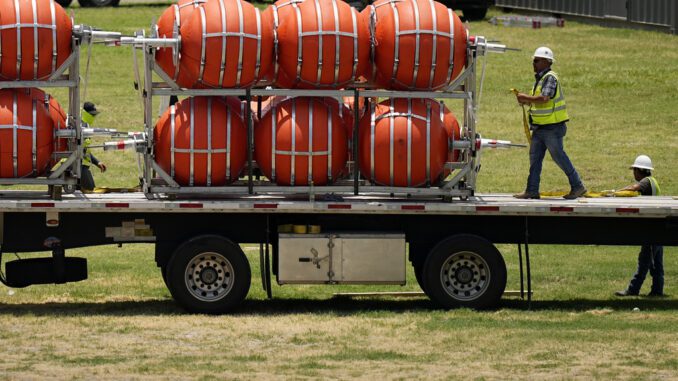
EAGLE PASS, Texas — Texas began rolling out what is set to become a new floating barrier on the Rio Grande in the latest escalation of Republican Gov. Greg Abbott’s multibillion-dollar effort to secure the U.S. border with Mexico, which already has included bussing migrants to liberal states and authorizing the National Guard to make arrests.
But even before the huge, orange buoys were unloaded from the trailers that hauled them to the border city of Eagle Pass, there were concerns over this part of Abbott’s unprecedented challenge to the federal government’s authority over immigration enforcement. Migrant advocates voiced concerns about drowning risks and environmentalists questioned the impact on the river.
Dozens of the large spherical buoys were stacked on the beds of four tractor trailers in a grassy city park near the river on Friday morning.
Setting up the barriers could take up to two weeks, according to Lt. Chris Olivarez, a spokesperson for the Texas Department of Public Safety, which is overseeing the project.
Once installed, the above-river parts of the system and the webbing they’re connected with will cover 1,000 feet of the middle of the Rio Grande, with anchors in the riverbed.
Eagle Pass is part of a Border Patrol sector that has seen the second highest number of migrant crossings this fiscal year with about 270,000 encounters — though that is lower than it was at this time last year.
The crossing dynamics shifted in May after the Biden administration stopped implementing Title 42, a pandemic era public health policy that turned many asylum seekers back to Mexico. New rules allowed people to seek asylum through a government application and set up appointments at the ports of entry, though the maximum allowed in per day is set at 1,450. The Texas governor’s policies target the many who are frustrated with the cap and cross illegally through the river.
Earlier iterations of Abbott’s border mission have included installing miles of razor wire at popular crossing points on the river and creating state checkpoints beyond federal stops to inspect incoming commercial traffic.
“We always look to employ whatever strategies will be effective in securing the border,” Abbott said in a June 8 press conference to introduce the buoy strategy.
Immigrant advocates, including Sister Isabel Turcios, a nun who oversees a migrant shelter in Piedras Negras, Mexico, which sits just across the river from Eagle Pass, have remained vigilant about the effects of the new barrier on migration. Turcios said she met with the Texas Department of Public Safety in the days leading up to the arrival of the buoys and was told the floating barrier would be placed in deep waters to function as a warning to migrants to avoid the area.
Turcios said she is aware that many of the nearly 200 migrants staying in her shelter on any given day are not deterred from crossing illegally despite sharp concertina wire. But that wire causes more danger because it forces migrants to spend additional time in the river.
“That’s more and more dangerous each time … because it has perches, it has whirlpools and because of the organized crime,” Turcios said.
Texas Department of Public Safety Director Steven McCraw addressed the danger that migrants may face when the buoys are deployed during the June press conference when Abbott spoke: “Anytime they get in that water, it’s a risk to the migrants. This is the deterrent from even coming in the water.”
Jessie Fuentes, who owns a canoe and kayaking business that takes paddlers onto the Rio Grande, said he’s worried about unforeseen consequences. On Friday, he filed a lawsuit to stop Texas from using the buoys. He’s seeking a permanent injunction, saying his paddling business is impacted by limited access to the river.
“I know it’s a detriment to the river flow, to the ecology of the river, to the fauna and flora. Every aspect of nature is being affected when you put something that doesn’t belong in the river,” Fuentes said.



